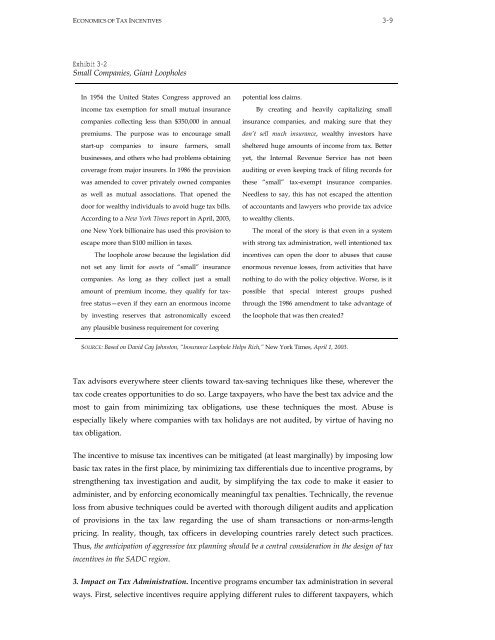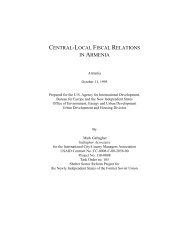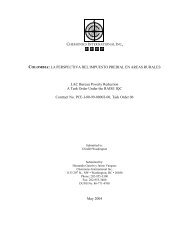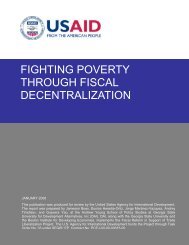Effectiveness and Economic Impact of Tax Incentives in the SADC ...
Effectiveness and Economic Impact of Tax Incentives in the SADC ...
Effectiveness and Economic Impact of Tax Incentives in the SADC ...
Create successful ePaper yourself
Turn your PDF publications into a flip-book with our unique Google optimized e-Paper software.
ECONOMICS OF TAX INCENTIVES 3-9<br />
Exhibit 3-2<br />
Small Companies, Giant Loopholes<br />
In 1954 <strong>the</strong> United States Congress approved an<br />
<strong>in</strong>come tax exemption for small mutual <strong>in</strong>surance<br />
companies collect<strong>in</strong>g less than $350,000 <strong>in</strong> annual<br />
premiums. The purpose was to encourage small<br />
start-up companies to <strong>in</strong>sure farmers, small<br />
bus<strong>in</strong>esses, <strong>and</strong> o<strong>the</strong>rs who had problems obta<strong>in</strong><strong>in</strong>g<br />
coverage from major <strong>in</strong>surers. In 1986 <strong>the</strong> provision<br />
was amended to cover privately owned companies<br />
as well as mutual associations. That opened <strong>the</strong><br />
door for wealthy <strong>in</strong>dividuals to avoid huge tax bills.<br />
Accord<strong>in</strong>g to a New York Times report <strong>in</strong> April, 2003,<br />
one New York billionaire has used this provision to<br />
escape more than $100 million <strong>in</strong> taxes.<br />
The loophole arose because <strong>the</strong> legislation did<br />
not set any limit for assets <strong>of</strong> “small” <strong>in</strong>surance<br />
companies. As long as <strong>the</strong>y collect just a small<br />
amount <strong>of</strong> premium <strong>in</strong>come, <strong>the</strong>y qualify for tax-<br />
free status—even if <strong>the</strong>y earn an enormous <strong>in</strong>come<br />
by <strong>in</strong>vest<strong>in</strong>g reserves that astronomically exceed<br />
any plausible bus<strong>in</strong>ess requirement for cover<strong>in</strong>g<br />
potential loss claims.<br />
By creat<strong>in</strong>g <strong>and</strong> heavily capitaliz<strong>in</strong>g small<br />
<strong>in</strong>surance companies, <strong>and</strong> mak<strong>in</strong>g sure that <strong>the</strong>y<br />
don’t sell much <strong>in</strong>surance, wealthy <strong>in</strong>vestors have<br />
sheltered huge amounts <strong>of</strong> <strong>in</strong>come from tax. Better<br />
yet, <strong>the</strong> Internal Revenue Service has not been<br />
audit<strong>in</strong>g or even keep<strong>in</strong>g track <strong>of</strong> fil<strong>in</strong>g records for<br />
<strong>the</strong>se “small” tax-exempt <strong>in</strong>surance companies.<br />
Needless to say, this has not escaped <strong>the</strong> attention<br />
<strong>of</strong> accountants <strong>and</strong> lawyers who provide tax advice<br />
to wealthy clients.<br />
The moral <strong>of</strong> <strong>the</strong> story is that even <strong>in</strong> a system<br />
with strong tax adm<strong>in</strong>istration, well <strong>in</strong>tentioned tax<br />
<strong>in</strong>centives can open <strong>the</strong> door to abuses that cause<br />
enormous revenue losses, from activities that have<br />
noth<strong>in</strong>g to do with <strong>the</strong> policy objective. Worse, is it<br />
possible that special <strong>in</strong>terest groups pushed<br />
through <strong>the</strong> 1986 amendment to take advantage <strong>of</strong><br />
<strong>the</strong> loophole that was <strong>the</strong>n created?<br />
SOURCE: Based on David Cay Johnston, “Insurance Loophole Helps Rich,” New York Times, April 1, 2003.<br />
<strong>Tax</strong> advisors everywhere steer clients toward tax-sav<strong>in</strong>g techniques like <strong>the</strong>se, wherever <strong>the</strong><br />
tax code creates opportunities to do so. Large taxpayers, who have <strong>the</strong> best tax advice <strong>and</strong> <strong>the</strong><br />
most to ga<strong>in</strong> from m<strong>in</strong>imiz<strong>in</strong>g tax obligations, use <strong>the</strong>se techniques <strong>the</strong> most. Abuse is<br />
especially likely where companies with tax holidays are not audited, by virtue <strong>of</strong> hav<strong>in</strong>g no<br />
tax obligation.<br />
The <strong>in</strong>centive to misuse tax <strong>in</strong>centives can be mitigated (at least marg<strong>in</strong>ally) by impos<strong>in</strong>g low<br />
basic tax rates <strong>in</strong> <strong>the</strong> first place, by m<strong>in</strong>imiz<strong>in</strong>g tax differentials due to <strong>in</strong>centive programs, by<br />
streng<strong>the</strong>n<strong>in</strong>g tax <strong>in</strong>vestigation <strong>and</strong> audit, by simplify<strong>in</strong>g <strong>the</strong> tax code to make it easier to<br />
adm<strong>in</strong>ister, <strong>and</strong> by enforc<strong>in</strong>g economically mean<strong>in</strong>gful tax penalties. Technically, <strong>the</strong> revenue<br />
loss from abusive techniques could be averted with thorough diligent audits <strong>and</strong> application<br />
<strong>of</strong> provisions <strong>in</strong> <strong>the</strong> tax law regard<strong>in</strong>g <strong>the</strong> use <strong>of</strong> sham transactions or non-arms-length<br />
pric<strong>in</strong>g. In reality, though, tax <strong>of</strong>ficers <strong>in</strong> develop<strong>in</strong>g countries rarely detect such practices.<br />
Thus, <strong>the</strong> anticipation <strong>of</strong> aggressive tax plann<strong>in</strong>g should be a central consideration <strong>in</strong> <strong>the</strong> design <strong>of</strong> tax<br />
<strong>in</strong>centives <strong>in</strong> <strong>the</strong> <strong>SADC</strong> region.<br />
3. <strong>Impact</strong> on <strong>Tax</strong> Adm<strong>in</strong>istration. Incentive programs encumber tax adm<strong>in</strong>istration <strong>in</strong> several<br />
ways. First, selective <strong>in</strong>centives require apply<strong>in</strong>g different rules to different taxpayers, which











